Business Economics: Market Equilibrium, Price Floors, and Tariffs
VerifiedAdded on 2022/08/24
|13
|1990
|16
Homework Assignment
AI Summary
This Business Economics assignment analyzes market equilibrium, price floors, and tariffs using supply and demand models. The first part examines the banana market, demonstrating market equilibrium, the impact of price changes, and shifts in supply and demand. The second part investigates t...
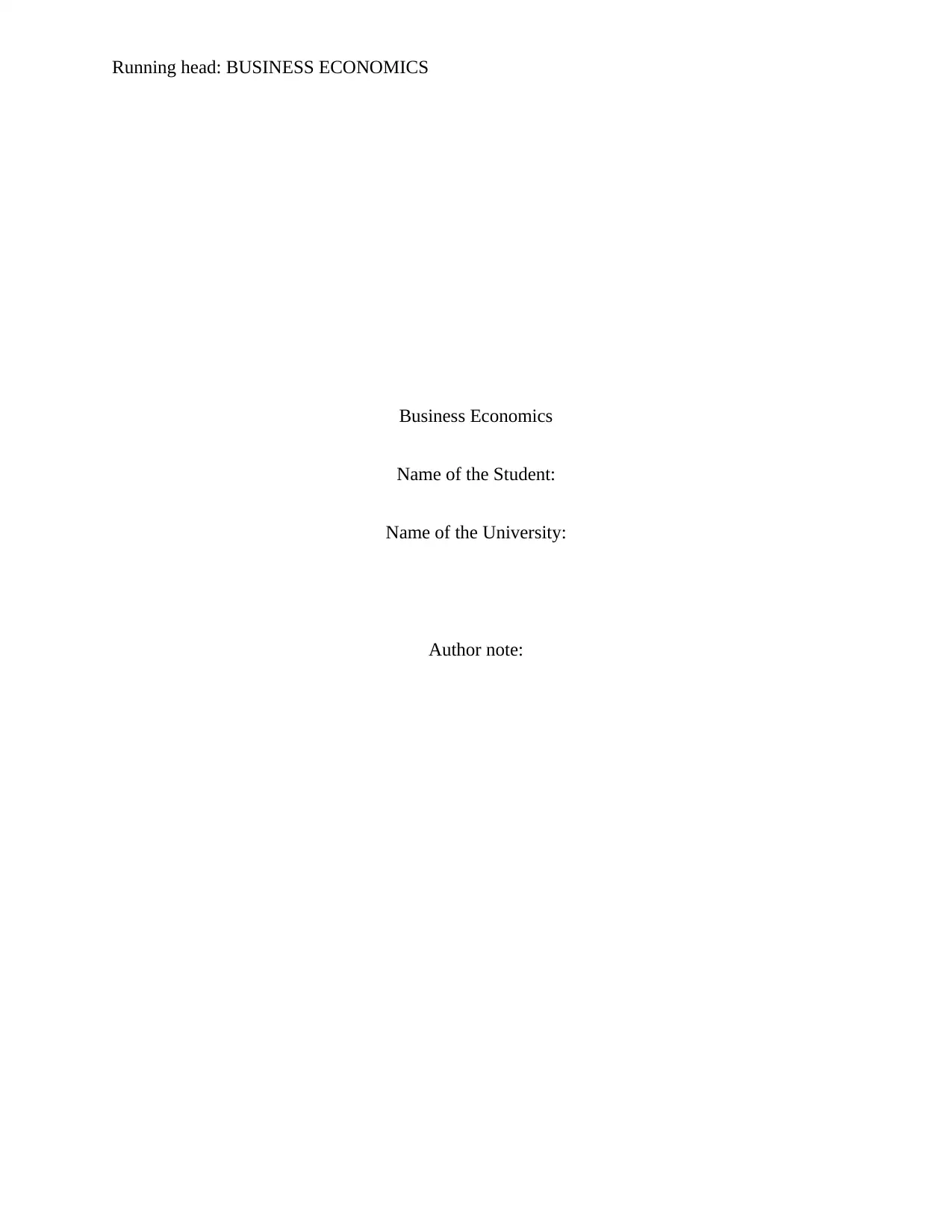
Running head: BUSINESS ECONOMICS
Business Economics
Name of the Student:
Name of the University:
Author note:
Business Economics
Name of the Student:
Name of the University:
Author note:
Paraphrase This Document
Need a fresh take? Get an instant paraphrase of this document with our AI Paraphraser
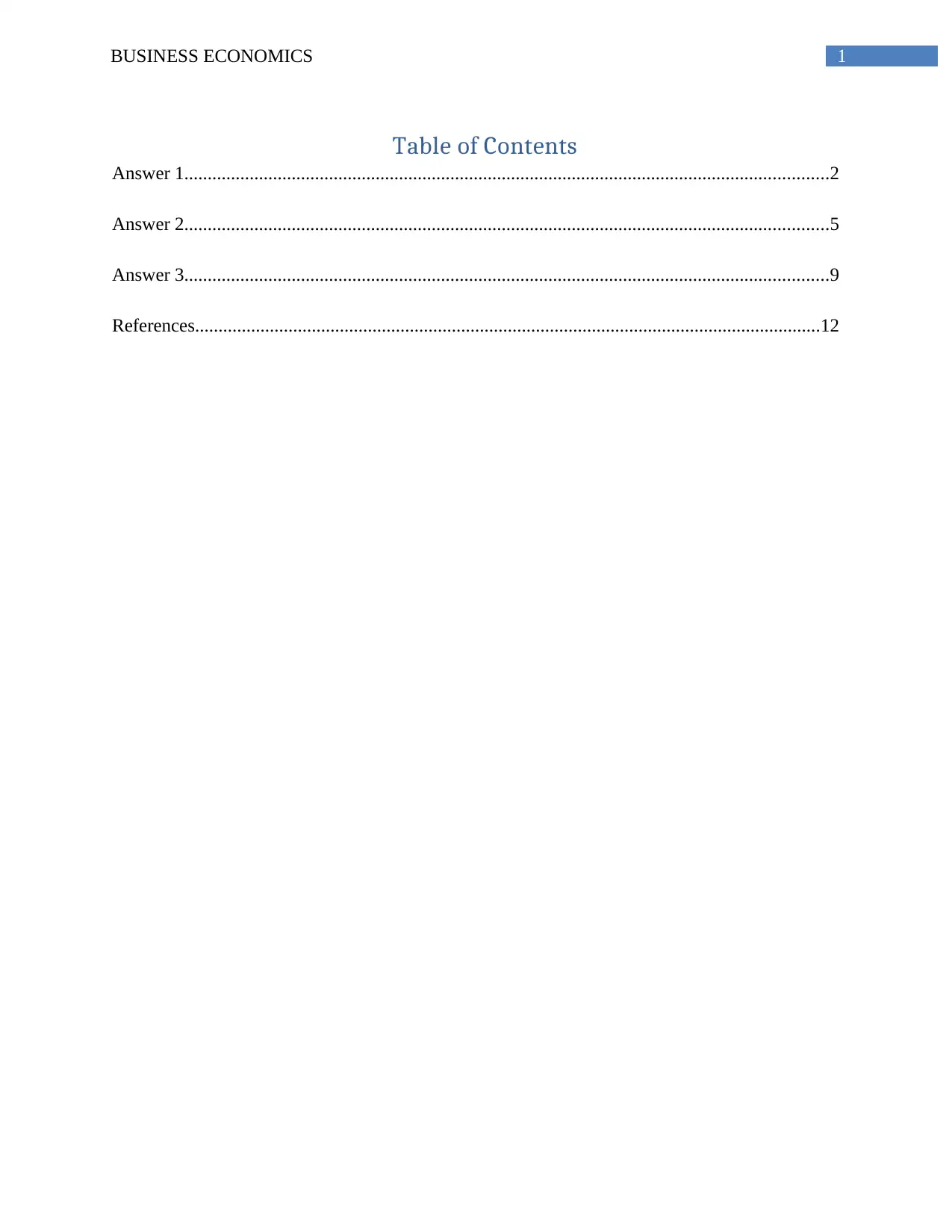
1BUSINESS ECONOMICS
Table of Contents
Answer 1..........................................................................................................................................2
Answer 2..........................................................................................................................................5
Answer 3..........................................................................................................................................9
References......................................................................................................................................12
Table of Contents
Answer 1..........................................................................................................................................2
Answer 2..........................................................................................................................................5
Answer 3..........................................................................................................................................9
References......................................................................................................................................12
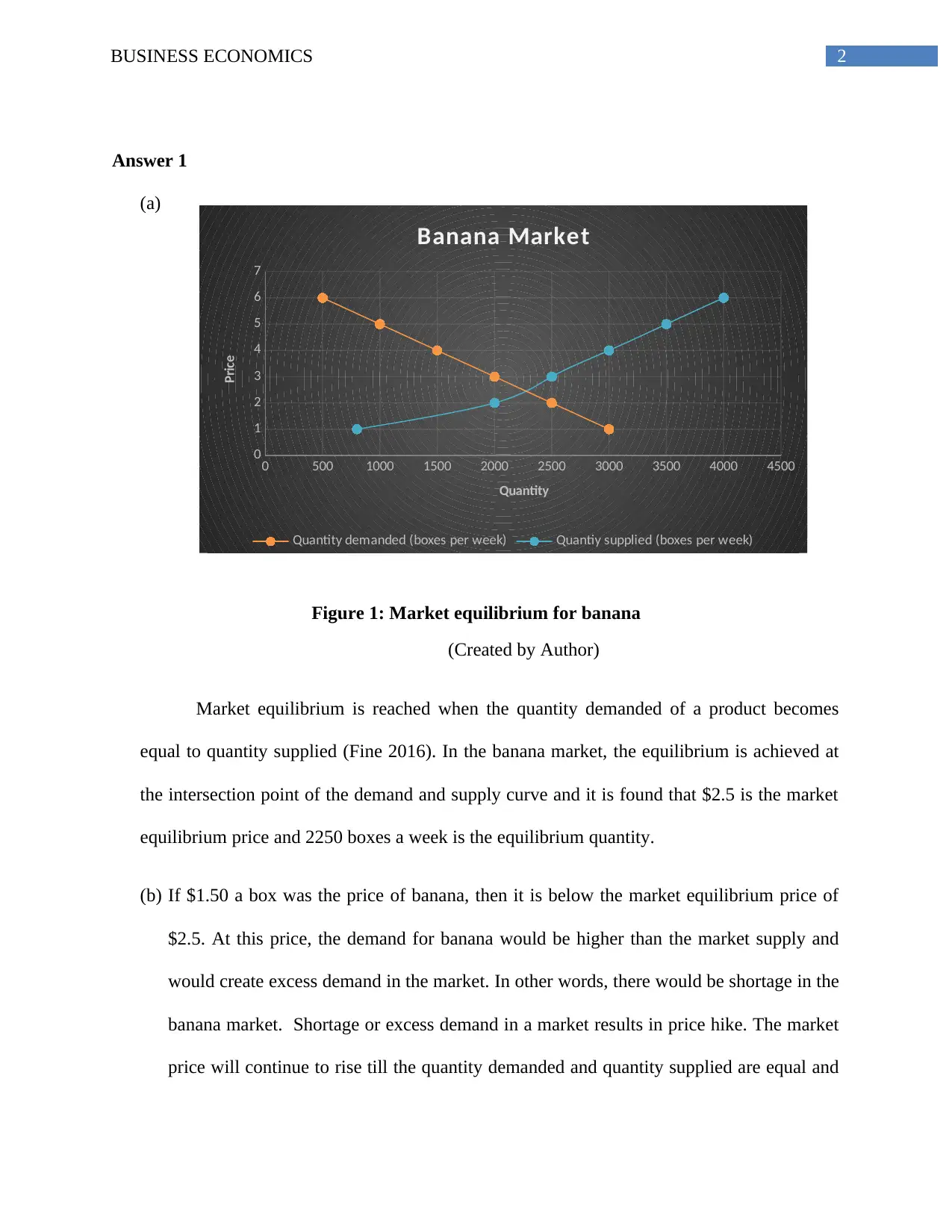
2BUSINESS ECONOMICS
Answer 1
(a)
Figure 1: Market equilibrium for banana
(Created by Author)
Market equilibrium is reached when the quantity demanded of a product becomes
equal to quantity supplied (Fine 2016). In the banana market, the equilibrium is achieved at
the intersection point of the demand and supply curve and it is found that $2.5 is the market
equilibrium price and 2250 boxes a week is the equilibrium quantity.
(b) If $1.50 a box was the price of banana, then it is below the market equilibrium price of
$2.5. At this price, the demand for banana would be higher than the market supply and
would create excess demand in the market. In other words, there would be shortage in the
banana market. Shortage or excess demand in a market results in price hike. The market
price will continue to rise till the quantity demanded and quantity supplied are equal and
0 500 1000 1500 2000 2500 3000 3500 4000 4500
0
1
2
3
4
5
6
7
Banana Market
Quantity demanded (boxes per week) Quantiy supplied (boxes per week)
Quantity
Price
Answer 1
(a)
Figure 1: Market equilibrium for banana
(Created by Author)
Market equilibrium is reached when the quantity demanded of a product becomes
equal to quantity supplied (Fine 2016). In the banana market, the equilibrium is achieved at
the intersection point of the demand and supply curve and it is found that $2.5 is the market
equilibrium price and 2250 boxes a week is the equilibrium quantity.
(b) If $1.50 a box was the price of banana, then it is below the market equilibrium price of
$2.5. At this price, the demand for banana would be higher than the market supply and
would create excess demand in the market. In other words, there would be shortage in the
banana market. Shortage or excess demand in a market results in price hike. The market
price will continue to rise till the quantity demanded and quantity supplied are equal and
0 500 1000 1500 2000 2500 3000 3500 4000 4500
0
1
2
3
4
5
6
7
Banana Market
Quantity demanded (boxes per week) Quantiy supplied (boxes per week)
Quantity
Price
⊘ This is a preview!⊘
Do you want full access?
Subscribe today to unlock all pages.

Trusted by 1+ million students worldwide
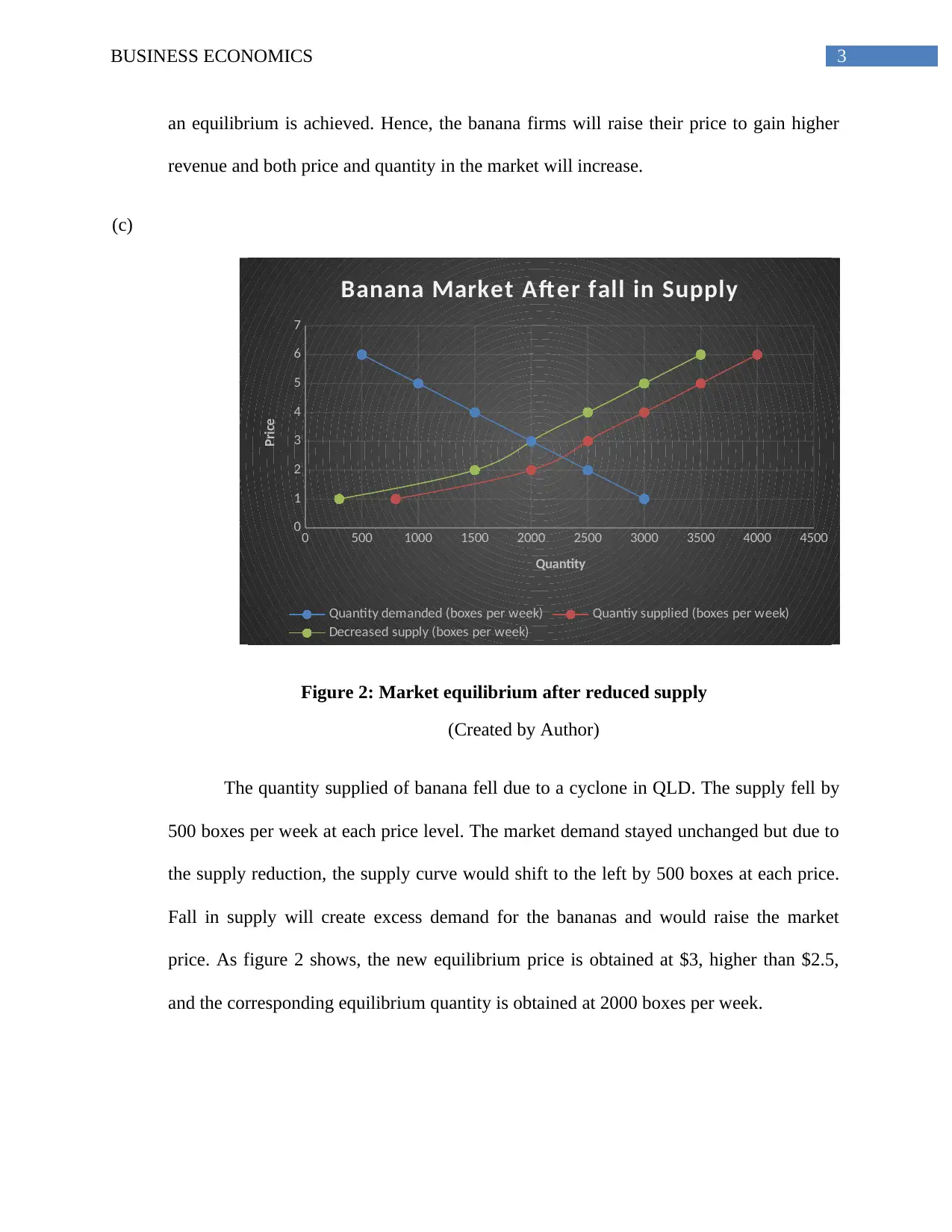
3BUSINESS ECONOMICS
an equilibrium is achieved. Hence, the banana firms will raise their price to gain higher
revenue and both price and quantity in the market will increase.
(c)
Figure 2: Market equilibrium after reduced supply
(Created by Author)
The quantity supplied of banana fell due to a cyclone in QLD. The supply fell by
500 boxes per week at each price level. The market demand stayed unchanged but due to
the supply reduction, the supply curve would shift to the left by 500 boxes at each price.
Fall in supply will create excess demand for the bananas and would raise the market
price. As figure 2 shows, the new equilibrium price is obtained at $3, higher than $2.5,
and the corresponding equilibrium quantity is obtained at 2000 boxes per week.
0 500 1000 1500 2000 2500 3000 3500 4000 4500
0
1
2
3
4
5
6
7
Banana Market After fall in Supply
Quantity demanded (boxes per week) Quantiy supplied (boxes per week)
Decreased supply (boxes per week)
Quantity
Price
an equilibrium is achieved. Hence, the banana firms will raise their price to gain higher
revenue and both price and quantity in the market will increase.
(c)
Figure 2: Market equilibrium after reduced supply
(Created by Author)
The quantity supplied of banana fell due to a cyclone in QLD. The supply fell by
500 boxes per week at each price level. The market demand stayed unchanged but due to
the supply reduction, the supply curve would shift to the left by 500 boxes at each price.
Fall in supply will create excess demand for the bananas and would raise the market
price. As figure 2 shows, the new equilibrium price is obtained at $3, higher than $2.5,
and the corresponding equilibrium quantity is obtained at 2000 boxes per week.
0 500 1000 1500 2000 2500 3000 3500 4000 4500
0
1
2
3
4
5
6
7
Banana Market After fall in Supply
Quantity demanded (boxes per week) Quantiy supplied (boxes per week)
Decreased supply (boxes per week)
Quantity
Price
Paraphrase This Document
Need a fresh take? Get an instant paraphrase of this document with our AI Paraphraser
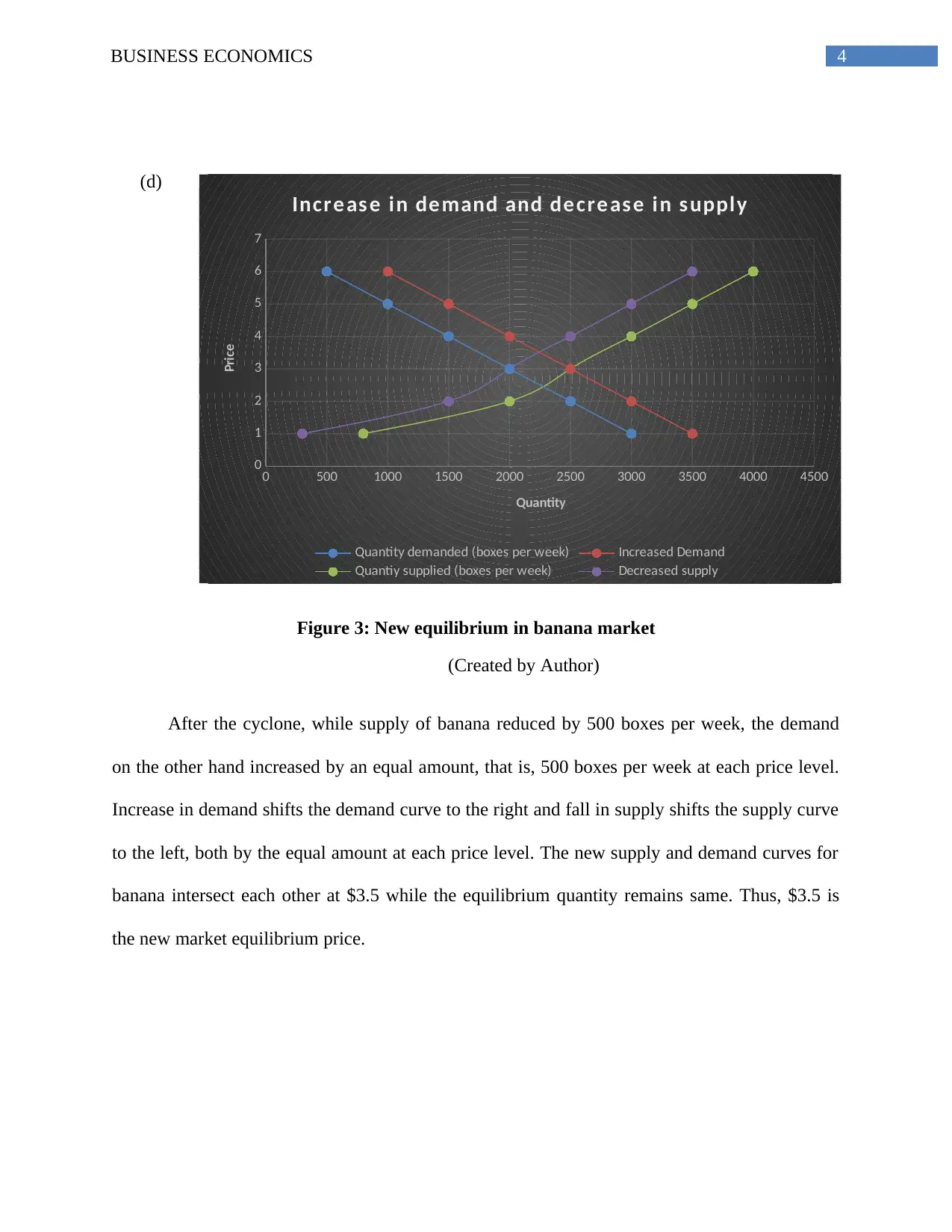
4BUSINESS ECONOMICS
(d)
Figure 3: New equilibrium in banana market
(Created by Author)
After the cyclone, while supply of banana reduced by 500 boxes per week, the demand
on the other hand increased by an equal amount, that is, 500 boxes per week at each price level.
Increase in demand shifts the demand curve to the right and fall in supply shifts the supply curve
to the left, both by the equal amount at each price level. The new supply and demand curves for
banana intersect each other at $3.5 while the equilibrium quantity remains same. Thus, $3.5 is
the new market equilibrium price.
0 500 1000 1500 2000 2500 3000 3500 4000 4500
0
1
2
3
4
5
6
7
Incre ase in demand and de cre ase in supply
Quantity demanded (boxes per week) Increased Demand
Quantiy supplied (boxes per week) Decreased supply
Quantity
Price
(d)
Figure 3: New equilibrium in banana market
(Created by Author)
After the cyclone, while supply of banana reduced by 500 boxes per week, the demand
on the other hand increased by an equal amount, that is, 500 boxes per week at each price level.
Increase in demand shifts the demand curve to the right and fall in supply shifts the supply curve
to the left, both by the equal amount at each price level. The new supply and demand curves for
banana intersect each other at $3.5 while the equilibrium quantity remains same. Thus, $3.5 is
the new market equilibrium price.
0 500 1000 1500 2000 2500 3000 3500 4000 4500
0
1
2
3
4
5
6
7
Incre ase in demand and de cre ase in supply
Quantity demanded (boxes per week) Increased Demand
Quantiy supplied (boxes per week) Decreased supply
Quantity
Price
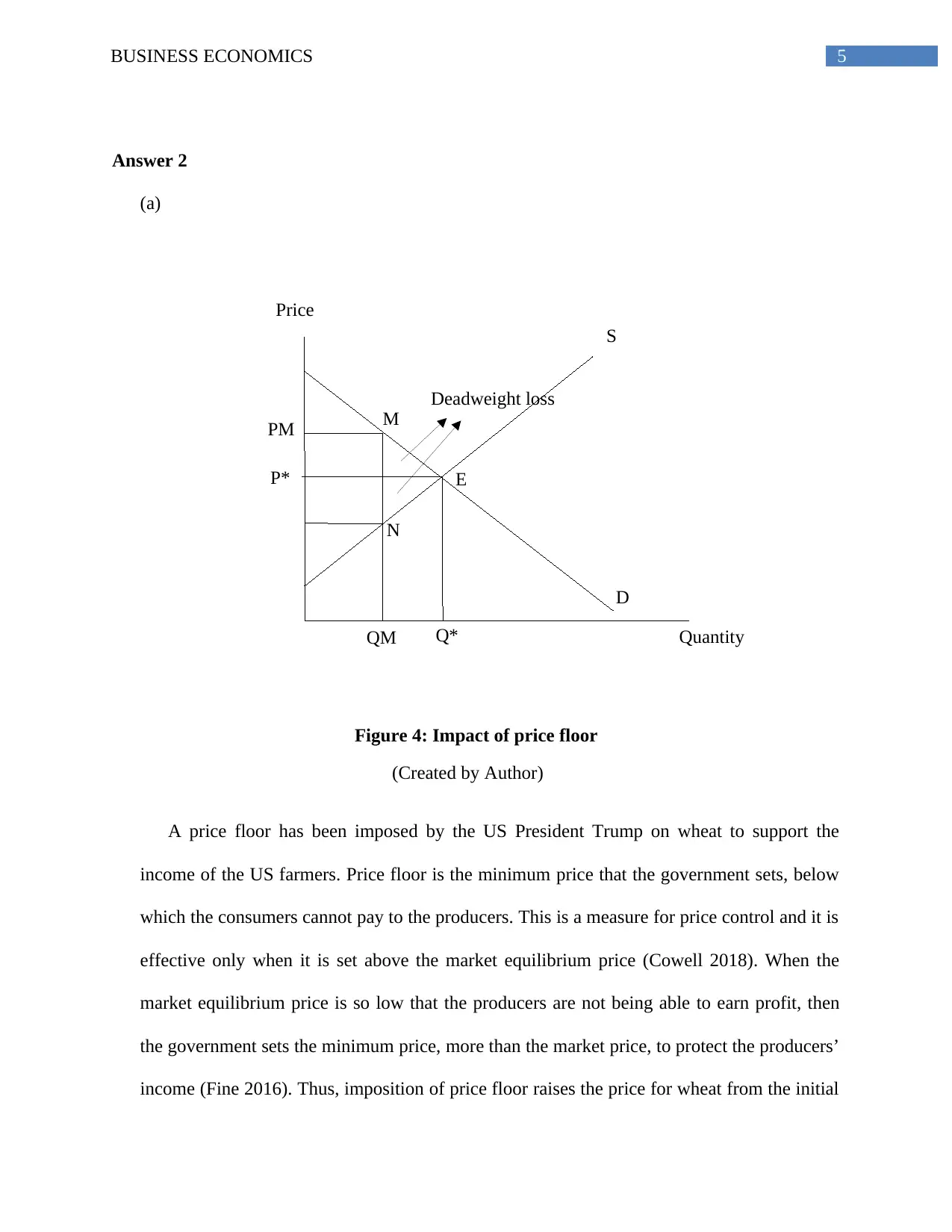
5BUSINESS ECONOMICS
Price
Quantity
S
D
Deadweight loss
P*
PM
Q*QM
M
N
E
Answer 2
(a)
Figure 4: Impact of price floor
(Created by Author)
A price floor has been imposed by the US President Trump on wheat to support the
income of the US farmers. Price floor is the minimum price that the government sets, below
which the consumers cannot pay to the producers. This is a measure for price control and it is
effective only when it is set above the market equilibrium price (Cowell 2018). When the
market equilibrium price is so low that the producers are not being able to earn profit, then
the government sets the minimum price, more than the market price, to protect the producers’
income (Fine 2016). Thus, imposition of price floor raises the price for wheat from the initial
Price
Quantity
S
D
Deadweight loss
P*
PM
Q*QM
M
N
E
Answer 2
(a)
Figure 4: Impact of price floor
(Created by Author)
A price floor has been imposed by the US President Trump on wheat to support the
income of the US farmers. Price floor is the minimum price that the government sets, below
which the consumers cannot pay to the producers. This is a measure for price control and it is
effective only when it is set above the market equilibrium price (Cowell 2018). When the
market equilibrium price is so low that the producers are not being able to earn profit, then
the government sets the minimum price, more than the market price, to protect the producers’
income (Fine 2016). Thus, imposition of price floor raises the price for wheat from the initial
⊘ This is a preview!⊘
Do you want full access?
Subscribe today to unlock all pages.

Trusted by 1+ million students worldwide
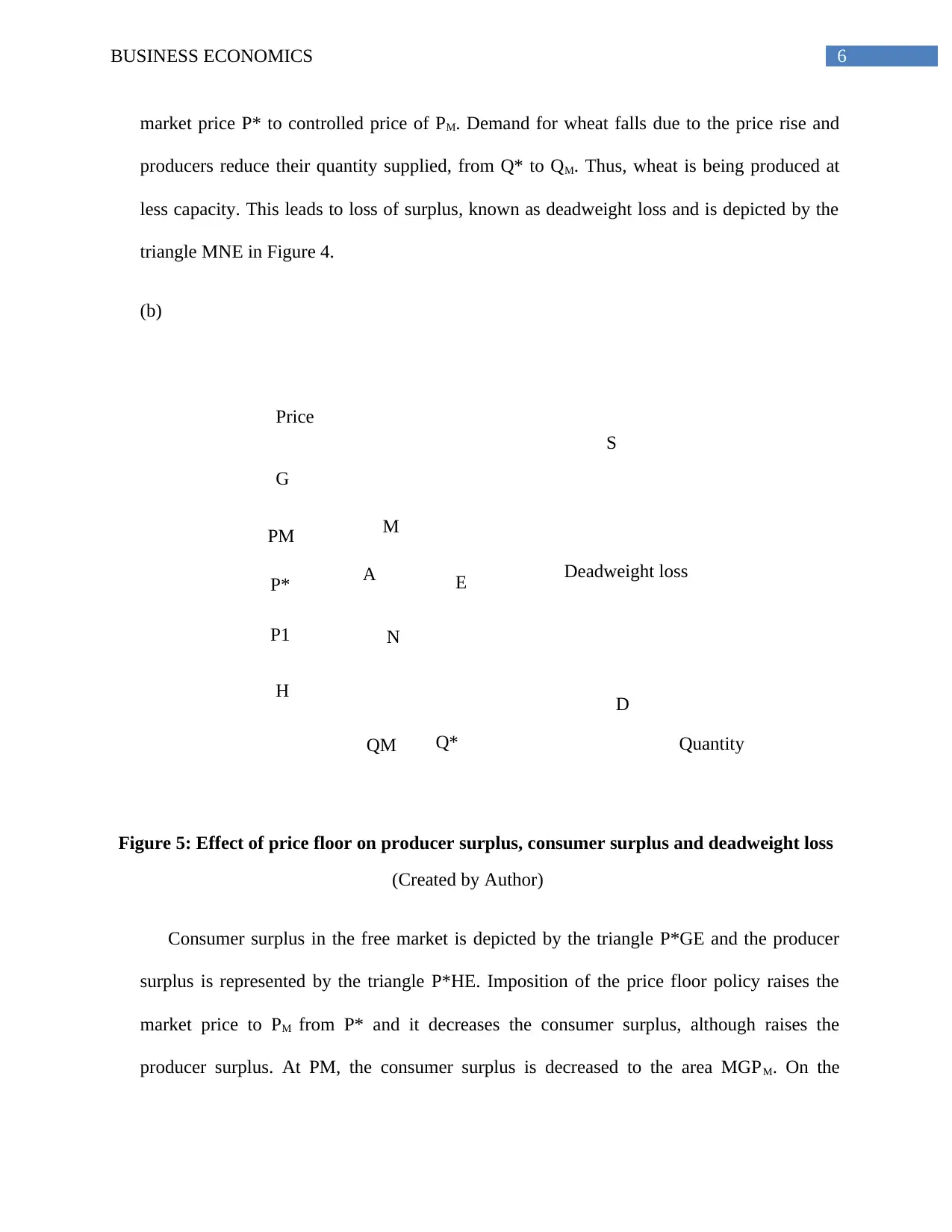
6BUSINESS ECONOMICS
Price
Quantity
S
D
Deadweight loss
P*
PM
Q*QM
M
N
E
P1
G
H
A
market price P* to controlled price of PM. Demand for wheat falls due to the price rise and
producers reduce their quantity supplied, from Q* to QM. Thus, wheat is being produced at
less capacity. This leads to loss of surplus, known as deadweight loss and is depicted by the
triangle MNE in Figure 4.
(b)
Figure 5: Effect of price floor on producer surplus, consumer surplus and deadweight loss
(Created by Author)
Consumer surplus in the free market is depicted by the triangle P*GE and the producer
surplus is represented by the triangle P*HE. Imposition of the price floor policy raises the
market price to PM from P* and it decreases the consumer surplus, although raises the
producer surplus. At PM, the consumer surplus is decreased to the area MGPM. On the
Price
Quantity
S
D
Deadweight loss
P*
PM
Q*QM
M
N
E
P1
G
H
A
market price P* to controlled price of PM. Demand for wheat falls due to the price rise and
producers reduce their quantity supplied, from Q* to QM. Thus, wheat is being produced at
less capacity. This leads to loss of surplus, known as deadweight loss and is depicted by the
triangle MNE in Figure 4.
(b)
Figure 5: Effect of price floor on producer surplus, consumer surplus and deadweight loss
(Created by Author)
Consumer surplus in the free market is depicted by the triangle P*GE and the producer
surplus is represented by the triangle P*HE. Imposition of the price floor policy raises the
market price to PM from P* and it decreases the consumer surplus, although raises the
producer surplus. At PM, the consumer surplus is decreased to the area MGPM. On the
Paraphrase This Document
Need a fresh take? Get an instant paraphrase of this document with our AI Paraphraser
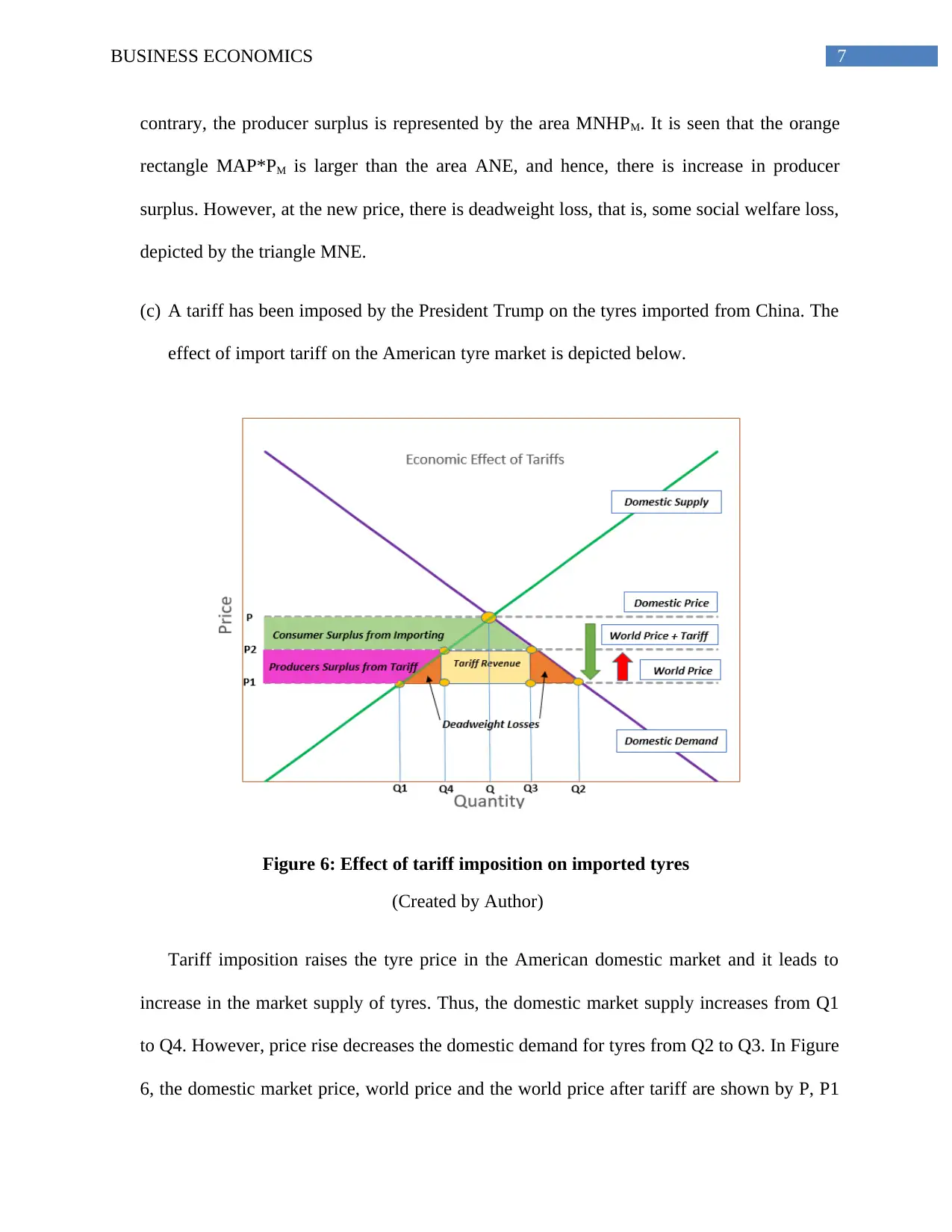
7BUSINESS ECONOMICS
contrary, the producer surplus is represented by the area MNHPM. It is seen that the orange
rectangle MAP*PM is larger than the area ANE, and hence, there is increase in producer
surplus. However, at the new price, there is deadweight loss, that is, some social welfare loss,
depicted by the triangle MNE.
(c) A tariff has been imposed by the President Trump on the tyres imported from China. The
effect of import tariff on the American tyre market is depicted below.
Figure 6: Effect of tariff imposition on imported tyres
(Created by Author)
Tariff imposition raises the tyre price in the American domestic market and it leads to
increase in the market supply of tyres. Thus, the domestic market supply increases from Q1
to Q4. However, price rise decreases the domestic demand for tyres from Q2 to Q3. In Figure
6, the domestic market price, world price and the world price after tariff are shown by P, P1
contrary, the producer surplus is represented by the area MNHPM. It is seen that the orange
rectangle MAP*PM is larger than the area ANE, and hence, there is increase in producer
surplus. However, at the new price, there is deadweight loss, that is, some social welfare loss,
depicted by the triangle MNE.
(c) A tariff has been imposed by the President Trump on the tyres imported from China. The
effect of import tariff on the American tyre market is depicted below.
Figure 6: Effect of tariff imposition on imported tyres
(Created by Author)
Tariff imposition raises the tyre price in the American domestic market and it leads to
increase in the market supply of tyres. Thus, the domestic market supply increases from Q1
to Q4. However, price rise decreases the domestic demand for tyres from Q2 to Q3. In Figure
6, the domestic market price, world price and the world price after tariff are shown by P, P1
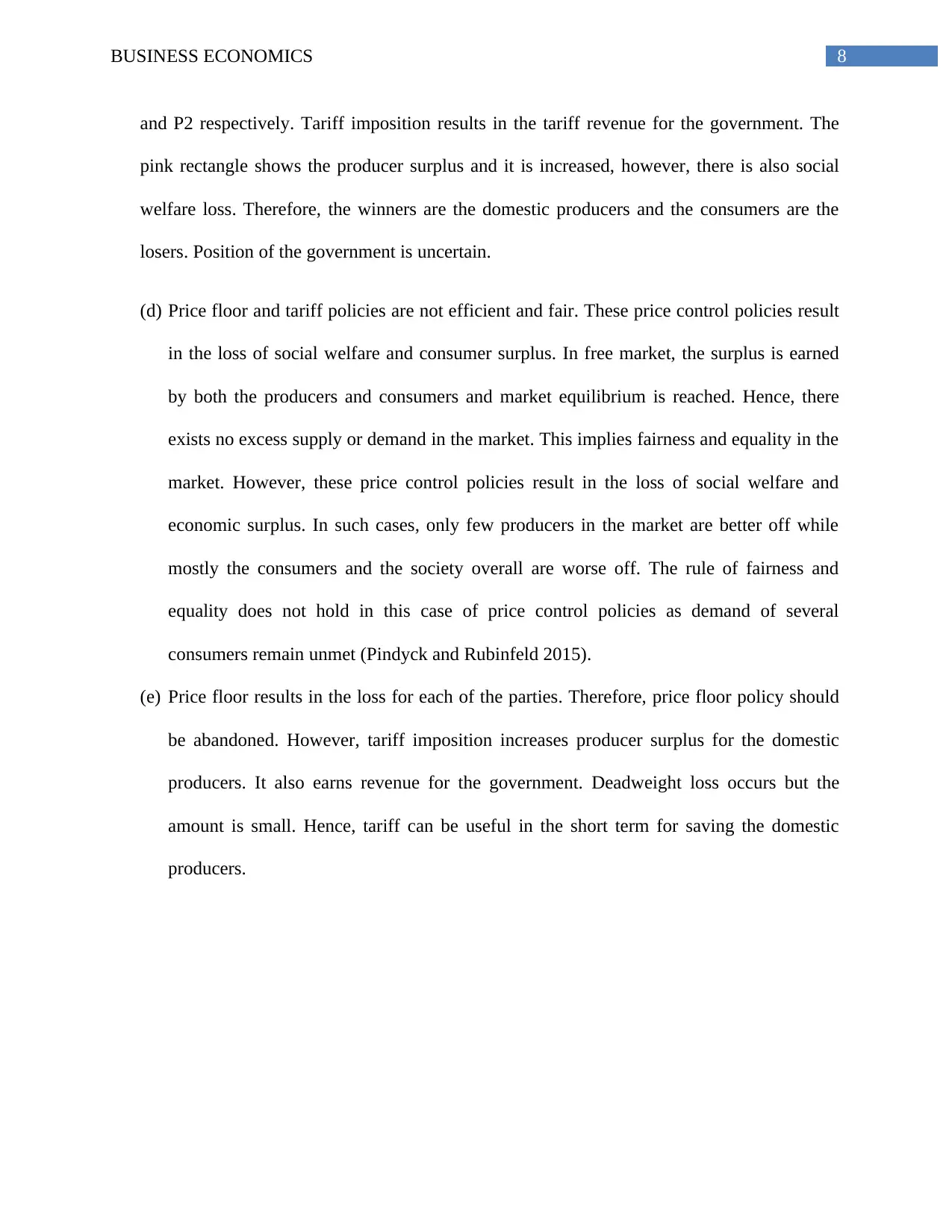
8BUSINESS ECONOMICS
and P2 respectively. Tariff imposition results in the tariff revenue for the government. The
pink rectangle shows the producer surplus and it is increased, however, there is also social
welfare loss. Therefore, the winners are the domestic producers and the consumers are the
losers. Position of the government is uncertain.
(d) Price floor and tariff policies are not efficient and fair. These price control policies result
in the loss of social welfare and consumer surplus. In free market, the surplus is earned
by both the producers and consumers and market equilibrium is reached. Hence, there
exists no excess supply or demand in the market. This implies fairness and equality in the
market. However, these price control policies result in the loss of social welfare and
economic surplus. In such cases, only few producers in the market are better off while
mostly the consumers and the society overall are worse off. The rule of fairness and
equality does not hold in this case of price control policies as demand of several
consumers remain unmet (Pindyck and Rubinfeld 2015).
(e) Price floor results in the loss for each of the parties. Therefore, price floor policy should
be abandoned. However, tariff imposition increases producer surplus for the domestic
producers. It also earns revenue for the government. Deadweight loss occurs but the
amount is small. Hence, tariff can be useful in the short term for saving the domestic
producers.
and P2 respectively. Tariff imposition results in the tariff revenue for the government. The
pink rectangle shows the producer surplus and it is increased, however, there is also social
welfare loss. Therefore, the winners are the domestic producers and the consumers are the
losers. Position of the government is uncertain.
(d) Price floor and tariff policies are not efficient and fair. These price control policies result
in the loss of social welfare and consumer surplus. In free market, the surplus is earned
by both the producers and consumers and market equilibrium is reached. Hence, there
exists no excess supply or demand in the market. This implies fairness and equality in the
market. However, these price control policies result in the loss of social welfare and
economic surplus. In such cases, only few producers in the market are better off while
mostly the consumers and the society overall are worse off. The rule of fairness and
equality does not hold in this case of price control policies as demand of several
consumers remain unmet (Pindyck and Rubinfeld 2015).
(e) Price floor results in the loss for each of the parties. Therefore, price floor policy should
be abandoned. However, tariff imposition increases producer surplus for the domestic
producers. It also earns revenue for the government. Deadweight loss occurs but the
amount is small. Hence, tariff can be useful in the short term for saving the domestic
producers.
⊘ This is a preview!⊘
Do you want full access?
Subscribe today to unlock all pages.

Trusted by 1+ million students worldwide
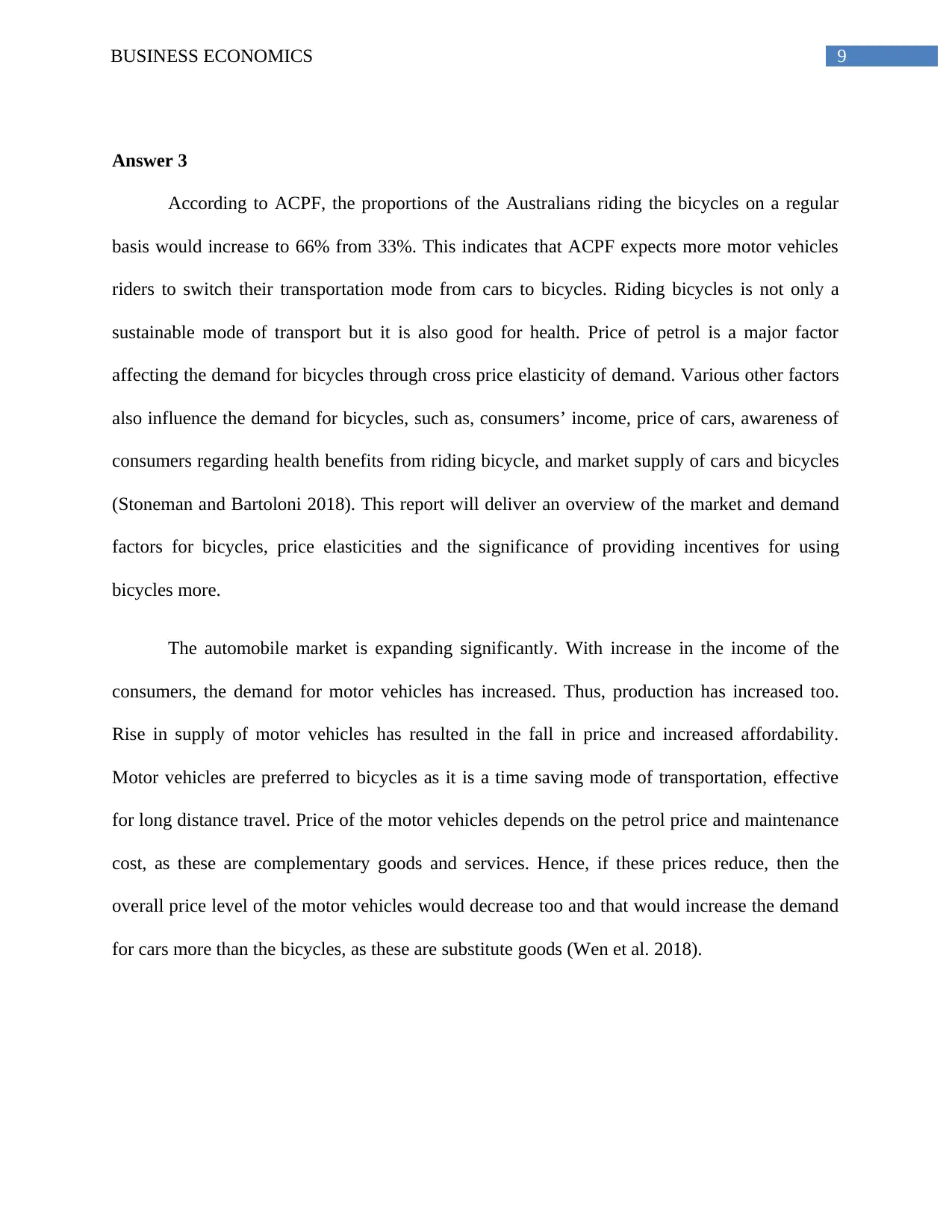
9BUSINESS ECONOMICS
Answer 3
According to ACPF, the proportions of the Australians riding the bicycles on a regular
basis would increase to 66% from 33%. This indicates that ACPF expects more motor vehicles
riders to switch their transportation mode from cars to bicycles. Riding bicycles is not only a
sustainable mode of transport but it is also good for health. Price of petrol is a major factor
affecting the demand for bicycles through cross price elasticity of demand. Various other factors
also influence the demand for bicycles, such as, consumers’ income, price of cars, awareness of
consumers regarding health benefits from riding bicycle, and market supply of cars and bicycles
(Stoneman and Bartoloni 2018). This report will deliver an overview of the market and demand
factors for bicycles, price elasticities and the significance of providing incentives for using
bicycles more.
The automobile market is expanding significantly. With increase in the income of the
consumers, the demand for motor vehicles has increased. Thus, production has increased too.
Rise in supply of motor vehicles has resulted in the fall in price and increased affordability.
Motor vehicles are preferred to bicycles as it is a time saving mode of transportation, effective
for long distance travel. Price of the motor vehicles depends on the petrol price and maintenance
cost, as these are complementary goods and services. Hence, if these prices reduce, then the
overall price level of the motor vehicles would decrease too and that would increase the demand
for cars more than the bicycles, as these are substitute goods (Wen et al. 2018).
Answer 3
According to ACPF, the proportions of the Australians riding the bicycles on a regular
basis would increase to 66% from 33%. This indicates that ACPF expects more motor vehicles
riders to switch their transportation mode from cars to bicycles. Riding bicycles is not only a
sustainable mode of transport but it is also good for health. Price of petrol is a major factor
affecting the demand for bicycles through cross price elasticity of demand. Various other factors
also influence the demand for bicycles, such as, consumers’ income, price of cars, awareness of
consumers regarding health benefits from riding bicycle, and market supply of cars and bicycles
(Stoneman and Bartoloni 2018). This report will deliver an overview of the market and demand
factors for bicycles, price elasticities and the significance of providing incentives for using
bicycles more.
The automobile market is expanding significantly. With increase in the income of the
consumers, the demand for motor vehicles has increased. Thus, production has increased too.
Rise in supply of motor vehicles has resulted in the fall in price and increased affordability.
Motor vehicles are preferred to bicycles as it is a time saving mode of transportation, effective
for long distance travel. Price of the motor vehicles depends on the petrol price and maintenance
cost, as these are complementary goods and services. Hence, if these prices reduce, then the
overall price level of the motor vehicles would decrease too and that would increase the demand
for cars more than the bicycles, as these are substitute goods (Wen et al. 2018).
Paraphrase This Document
Need a fresh take? Get an instant paraphrase of this document with our AI Paraphraser
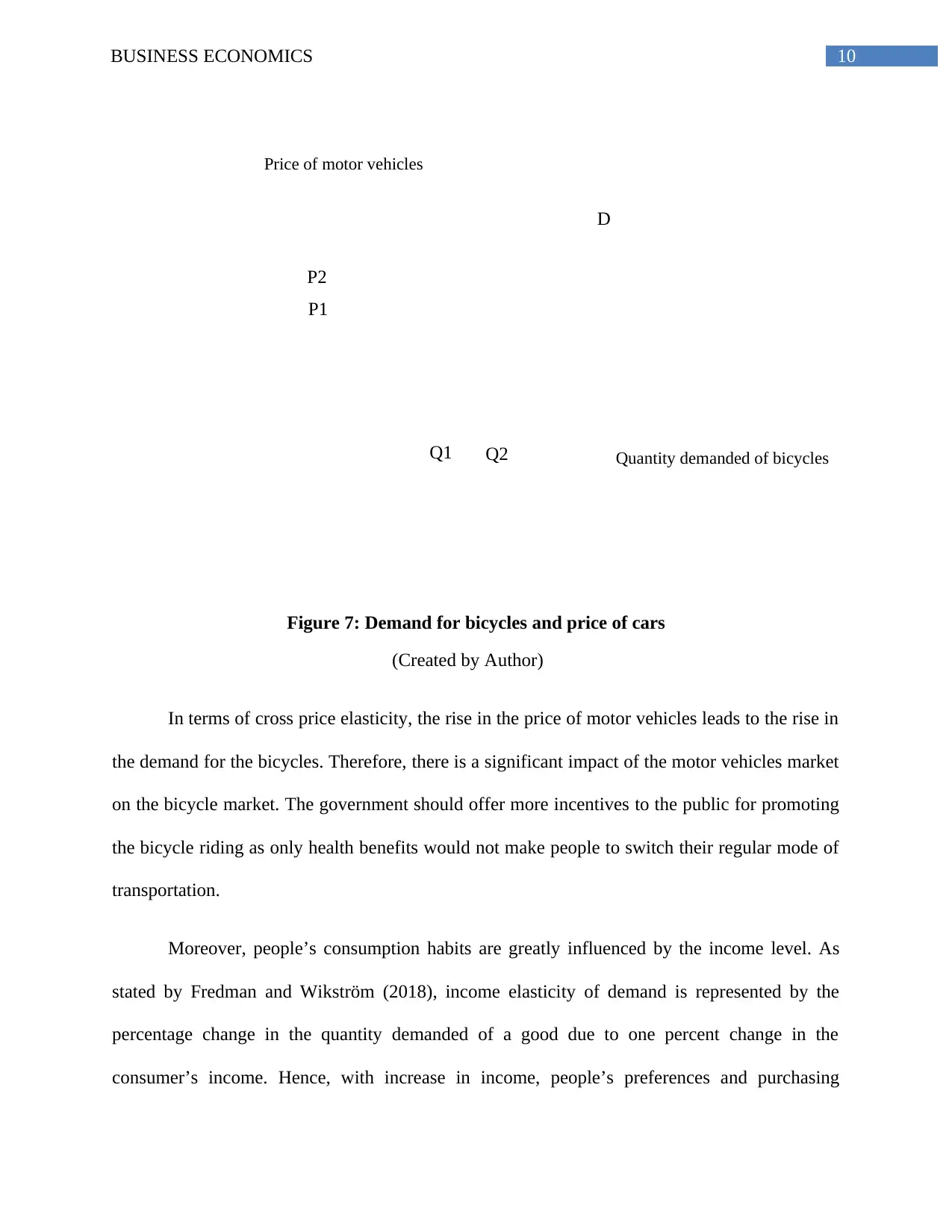
10BUSINESS ECONOMICS
D
Price of motor vehicles
Quantity demanded of bicycles
P1
P2
Q1 Q2
Figure 7: Demand for bicycles and price of cars
(Created by Author)
In terms of cross price elasticity, the rise in the price of motor vehicles leads to the rise in
the demand for the bicycles. Therefore, there is a significant impact of the motor vehicles market
on the bicycle market. The government should offer more incentives to the public for promoting
the bicycle riding as only health benefits would not make people to switch their regular mode of
transportation.
Moreover, people’s consumption habits are greatly influenced by the income level. As
stated by Fredman and Wikström (2018), income elasticity of demand is represented by the
percentage change in the quantity demanded of a good due to one percent change in the
consumer’s income. Hence, with increase in income, people’s preferences and purchasing
D
Price of motor vehicles
Quantity demanded of bicycles
P1
P2
Q1 Q2
Figure 7: Demand for bicycles and price of cars
(Created by Author)
In terms of cross price elasticity, the rise in the price of motor vehicles leads to the rise in
the demand for the bicycles. Therefore, there is a significant impact of the motor vehicles market
on the bicycle market. The government should offer more incentives to the public for promoting
the bicycle riding as only health benefits would not make people to switch their regular mode of
transportation.
Moreover, people’s consumption habits are greatly influenced by the income level. As
stated by Fredman and Wikström (2018), income elasticity of demand is represented by the
percentage change in the quantity demanded of a good due to one percent change in the
consumer’s income. Hence, with increase in income, people’s preferences and purchasing

11BUSINESS ECONOMICS
behavior change. In other words, when disposable income of the consumers increases, they
prefer to afford more luxury, and hence, demand for cars increases than that for the bicycles.
This leads to more sales of the cars than the bicycles. Along with that, the road condition and
traffic also influence the demand for bicycles. As bicycles are slower than the motor vehicles, it
is necessary to have better infrastructures and roads for a better bicycle riding experience for the
riders. Therefore, the government should improve the roads and traffic for encouraging people to
switch their mode of transport to bicycle. The public transport fare should also be increased to
encourage people to ride bicycles.
behavior change. In other words, when disposable income of the consumers increases, they
prefer to afford more luxury, and hence, demand for cars increases than that for the bicycles.
This leads to more sales of the cars than the bicycles. Along with that, the road condition and
traffic also influence the demand for bicycles. As bicycles are slower than the motor vehicles, it
is necessary to have better infrastructures and roads for a better bicycle riding experience for the
riders. Therefore, the government should improve the roads and traffic for encouraging people to
switch their mode of transport to bicycle. The public transport fare should also be increased to
encourage people to ride bicycles.
⊘ This is a preview!⊘
Do you want full access?
Subscribe today to unlock all pages.

Trusted by 1+ million students worldwide
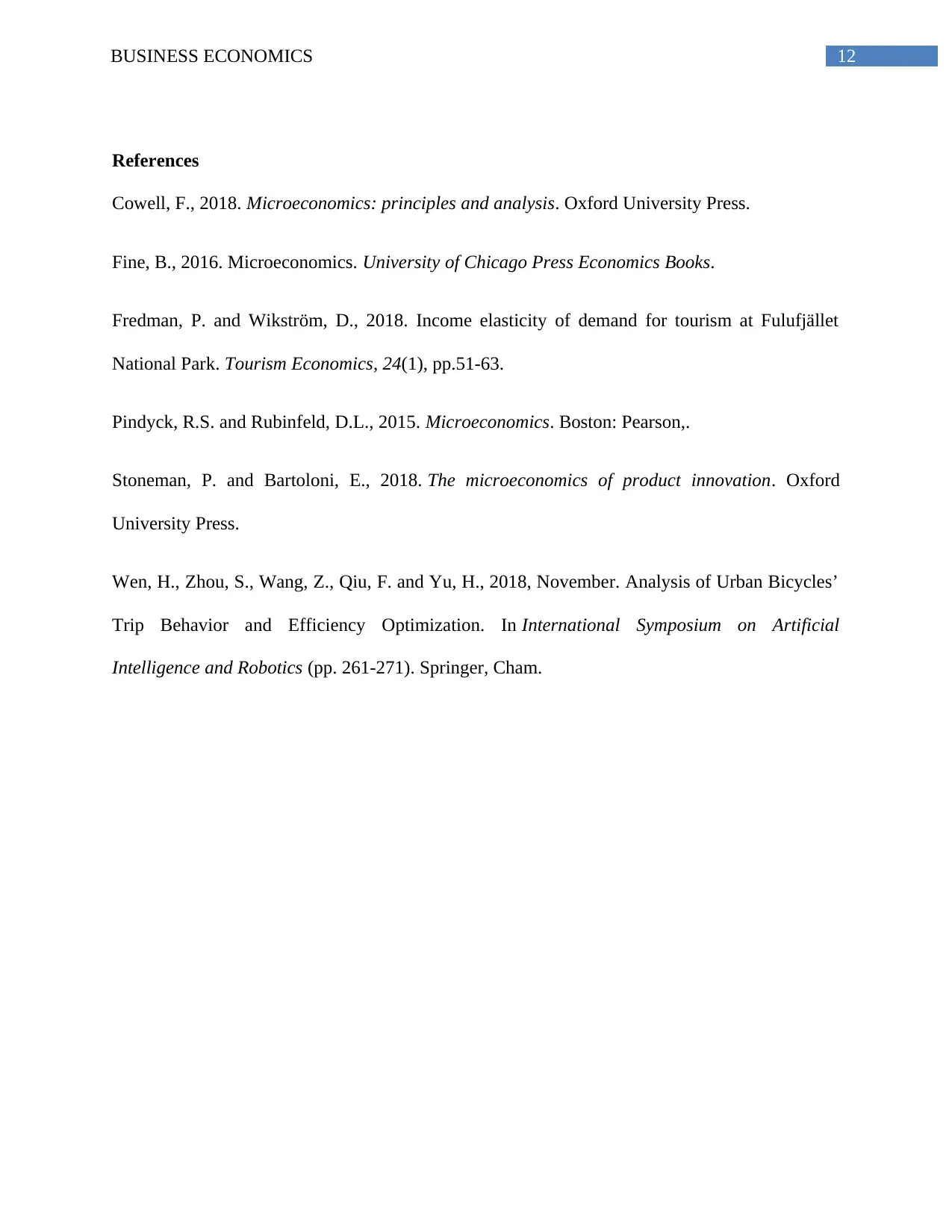
12BUSINESS ECONOMICS
References
Cowell, F., 2018. Microeconomics: principles and analysis. Oxford University Press.
Fine, B., 2016. Microeconomics. University of Chicago Press Economics Books.
Fredman, P. and Wikström, D., 2018. Income elasticity of demand for tourism at Fulufjället
National Park. Tourism Economics, 24(1), pp.51-63.
Pindyck, R.S. and Rubinfeld, D.L., 2015. Microeconomics. Boston: Pearson,.
Stoneman, P. and Bartoloni, E., 2018. The microeconomics of product innovation. Oxford
University Press.
Wen, H., Zhou, S., Wang, Z., Qiu, F. and Yu, H., 2018, November. Analysis of Urban Bicycles’
Trip Behavior and Efficiency Optimization. In International Symposium on Artificial
Intelligence and Robotics (pp. 261-271). Springer, Cham.
References
Cowell, F., 2018. Microeconomics: principles and analysis. Oxford University Press.
Fine, B., 2016. Microeconomics. University of Chicago Press Economics Books.
Fredman, P. and Wikström, D., 2018. Income elasticity of demand for tourism at Fulufjället
National Park. Tourism Economics, 24(1), pp.51-63.
Pindyck, R.S. and Rubinfeld, D.L., 2015. Microeconomics. Boston: Pearson,.
Stoneman, P. and Bartoloni, E., 2018. The microeconomics of product innovation. Oxford
University Press.
Wen, H., Zhou, S., Wang, Z., Qiu, F. and Yu, H., 2018, November. Analysis of Urban Bicycles’
Trip Behavior and Efficiency Optimization. In International Symposium on Artificial
Intelligence and Robotics (pp. 261-271). Springer, Cham.
1 out of 13
Related Documents
Your All-in-One AI-Powered Toolkit for Academic Success.
+13062052269
info@desklib.com
Available 24*7 on WhatsApp / Email
![[object Object]](/_next/static/media/star-bottom.7253800d.svg)
Unlock your academic potential
© 2024 | Zucol Services PVT LTD | All rights reserved.





